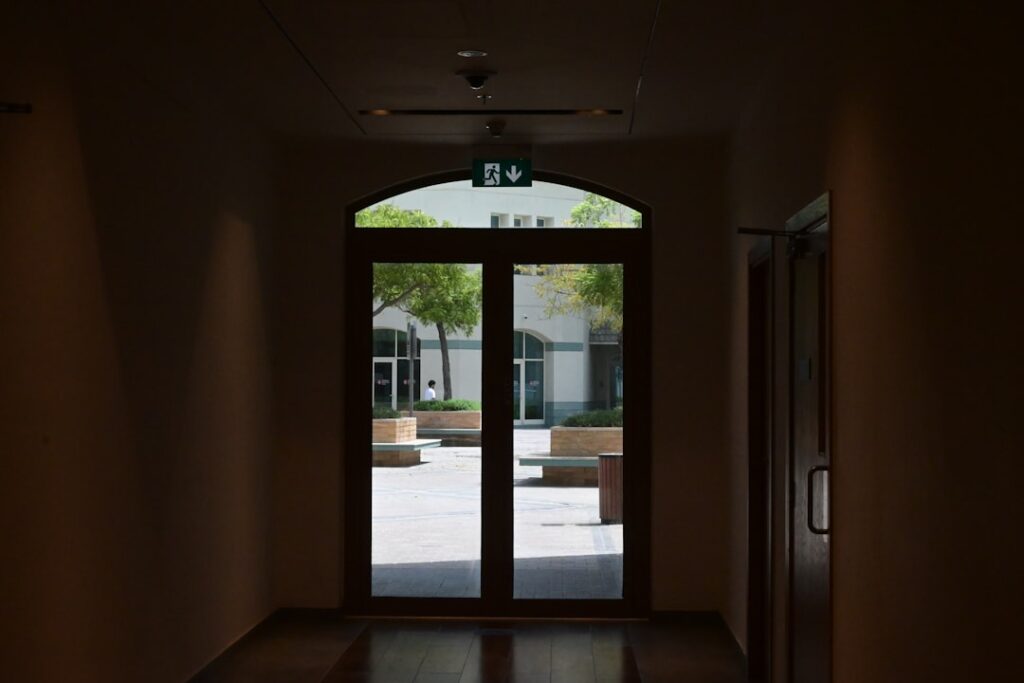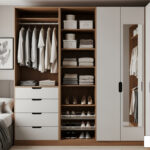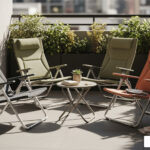Small entryway ideas: 7 Genius Space Hacks
Why Small Entryway Ideas Matter for Your Home
Small entryway ideas are essential for changing cramped, cluttered entry spaces into organized, welcoming zones that set the tone for your entire home. Whether you’re working with a narrow hallway or virtually no formal entryway at all, the right design choices can maximize every inch while creating a functional drop zone for keys, mail, shoes, and outerwear.
Quick Solutions for Small Entryways:
- Install wall hooks and floating shelves to use vertical space.
- Add a slim console table (under 12 inches deep) for a landing spot.
- Hang a large mirror to visually double your space.
- Use multi-functional furniture like storage benches or ottomans.
- Define the zone with a rug, especially in open-plan spaces.
- Choose bold wallpaper or paint to make the space feel intentional.
A well-organized entryway makes a tangible difference in your daily life. It’s where you transition from the outside world to your personal sanctuary. When it works well, you spend less time searching for keys, your morning routine flows smoother, and guests immediately feel welcomed. Even the smallest spaces can pack a punch when you approach them strategically, combining smart storage with visual appeal.
I’m Ramy Saber, a Civil Engineer and founder of Tiny Living Genius. I’ve spent years researching and testing practical solutions for maximizing functionality in compact living spaces. My experience has taught me that every square foot counts, and your entryway is no exception.
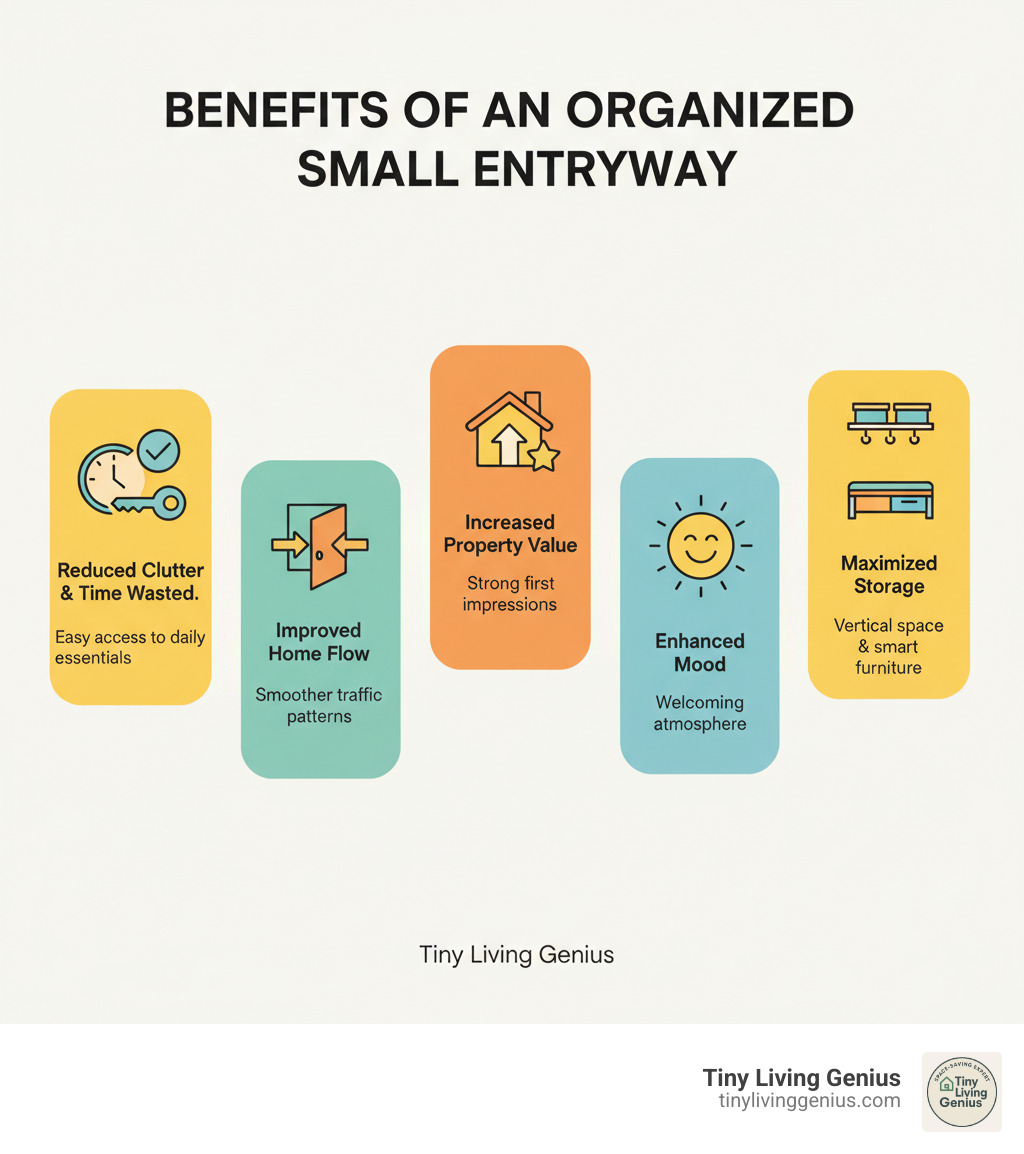
The Foundations of a Functional Small Entryway
Your entryway is the command center for your daily comings and goings and the first impression your home makes. For compact spaces, a functional entryway is key to a seamless transition from the outside world into your sanctuary. Think of it as a dedicated “drop zone” where keys, mail, and outerwear find their place, stopping clutter from spilling into the rest of your home.
Defining Your Entryway’s Core Functions
To design an effective entryway, consider what you do there every day. Here are the core functions to include in your small entryway ideas:
- A surface for mail/keys: An immediate drop zone for keys, your wallet, and mail.
- Seating for putting on shoes: A spot to sit down is a practical necessity.
- Storage for outerwear: Keeping coats, bags, and hats tidy is crucial for clear floors.
- A mirror for last-minute checks: A mirror is also a powerful design tool to make your space feel larger and brighter.
By defining these core functions, you ensure every item serves a purpose, contributing to an efficient design. For more guidance on maximizing every corner, explore our resources on efficient design for small spaces.
Common Mistakes to Avoid
In the quest for the perfect tiny entryway, it’s easy to fall into common traps. The biggest culprit is overcrowding, which leads to visual clutter and blocked pathways. It’s often better to leave a narrow space empty than to force in an item that doesn’t fit the scale.
Other frequent mistakes include ignoring vertical space, inadequate lighting that makes a space feel cramped, and the lack of a designated drop zone for keys and mail. Prioritizing style over function or choosing bulky furniture are also common missteps. If your entryway is just a small corner, consider storing coats and shoes elsewhere and turning the spot into a decorative feature. This maintains essential clearance, making your daily transitions smooth and stress-free.
Smart Furniture & Storage for Tight Spaces
When you’re working with a narrow hallway or a tiny corner, every piece of furniture needs to earn its place. This is where small entryway ideas get creative, focusing on furniture that does double duty and vertical storage that climbs walls instead of hogging floor space.
The secret is to think slim, vertical, and multi-functional. A console table that’s only 8 inches deep can still hold your keys, and a bench with hidden storage can stash scarves and leashes. Wall-mounted hooks and shelves keep everything accessible without blocking your path.
Maximizing Storage with Multi-Functional Pieces
In small entryways, single-purpose furniture is a luxury. Multi-functional pieces are your best friends.
Storage benches are the MVPs of compact entryways. A single bench can provide seating, hidden storage, and style. Some freestanding units combine a coat rack, a small seat, and shoe shelves all in one.
Wall-mounted cabinets with hooks are another smart choice, keeping items off the ground while offering concealed storage. Even a petite dresser can be repurposed as an entryway table, providing both a surface and drawers for tucking away papers.
Ottomans with hidden storage work beautifully in tight corners. Pop off the top to find a place for reusable bags or seasonal accessories. For more innovative ways to make your furniture work harder, check out our guide on creative furniture solutions for small spaces.
Essential Furniture for Your Small Entryway Ideas
Choosing the right furniture can make or break a small entryway. You want pieces that are slim, wall-mounted, or cleverly designed to avoid overwhelming the space.
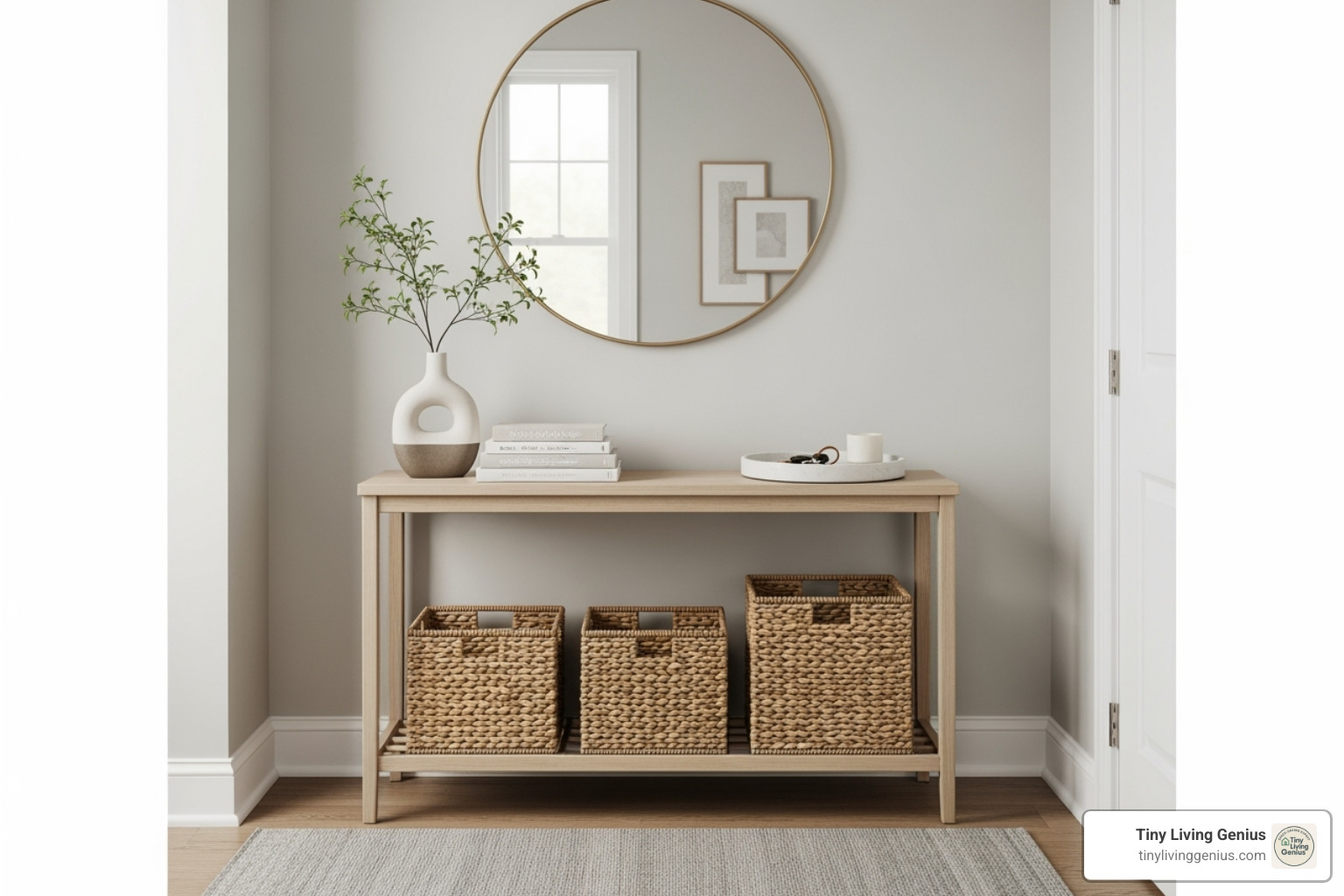
Slim console tables are lifesavers for narrow hallways, providing a landing spot for keys and mail without impeding traffic. Look for styles with a shelf underneath for baskets to hide clutter.
Floating shelves are brilliant for dropping keys and mail without taking up any floor space. A simple floating shelf under a mirror is both glamorous and practical.
Benches offer both seating and storage potential. A Scandi-style bench might offer integrated seating and a table surface, while a basic wooden bench has space beneath for storage baskets.
A single chair or stool is a great alternative if a bench is too wide. A cozy stool can add texture and a perfect spot for putting on shoes.
Corner units are often overlooked but can be incredibly useful in awkward entryways, providing storage without blocking walkways.
For an all-in-one solution, hall trees are ideal. A vintage or modern hall tree can provide hooks for coats, a spot for bags, and a shoe rack at the bottom. For a comprehensive guide on selecting pieces for your home, explore our best furniture ideas for small spaces.
Practical Solutions for Shoes and Outerwear
Shoes and coats are often the biggest clutter culprits. With the right storage, you can keep everything tidy.
Wall-mounted peg racks and individual hooks are incredibly versatile and take up zero floor space. Add hooks to a wall to hang everyday purses, hats, and jackets. You can install exactly as many as you need, where you need them.
Accordion coat racks are perfect for flexibility—they expand for guests and compress when you don’t need them.
Slim shoe cabinets are game-changers for keeping shoes out of sight while maximizing vertical space. These narrow units fit where traditional shoe racks wouldn’t.
Under-bench baskets are a flexible solution. A wicker basket can serve as an umbrella stand, while wire or woven bins can hide mail or other items, maintaining a minimalist look.
If you have under-stair space, don’t let it go to waste. Creatively placed cubbies under the stairs can provide significant storage without requiring additional floor space, changing an awkward area into a functional zone.
For more detailed strategies on decluttering, check out our smart storage solutions for small spaces.
Design Tricks to Make Your Entryway Feel Bigger and Brighter
While we can’t always add physical space, we can create the feeling of more space with clever visual tricks. By using mirrors, smart lighting, and impactful colors, we can turn a cozy entryway into a spot that feels open, welcoming, and full of personality. These small entryway ideas are all about making the most of what you have.
The Magic of Mirrors
Mirrors are like magic wands for small spaces. They instantly make a room feel bigger by bouncing light around, chasing away shadows, and making dark corners brighter. They also add a sense of depth that can make your entryway feel twice its size.
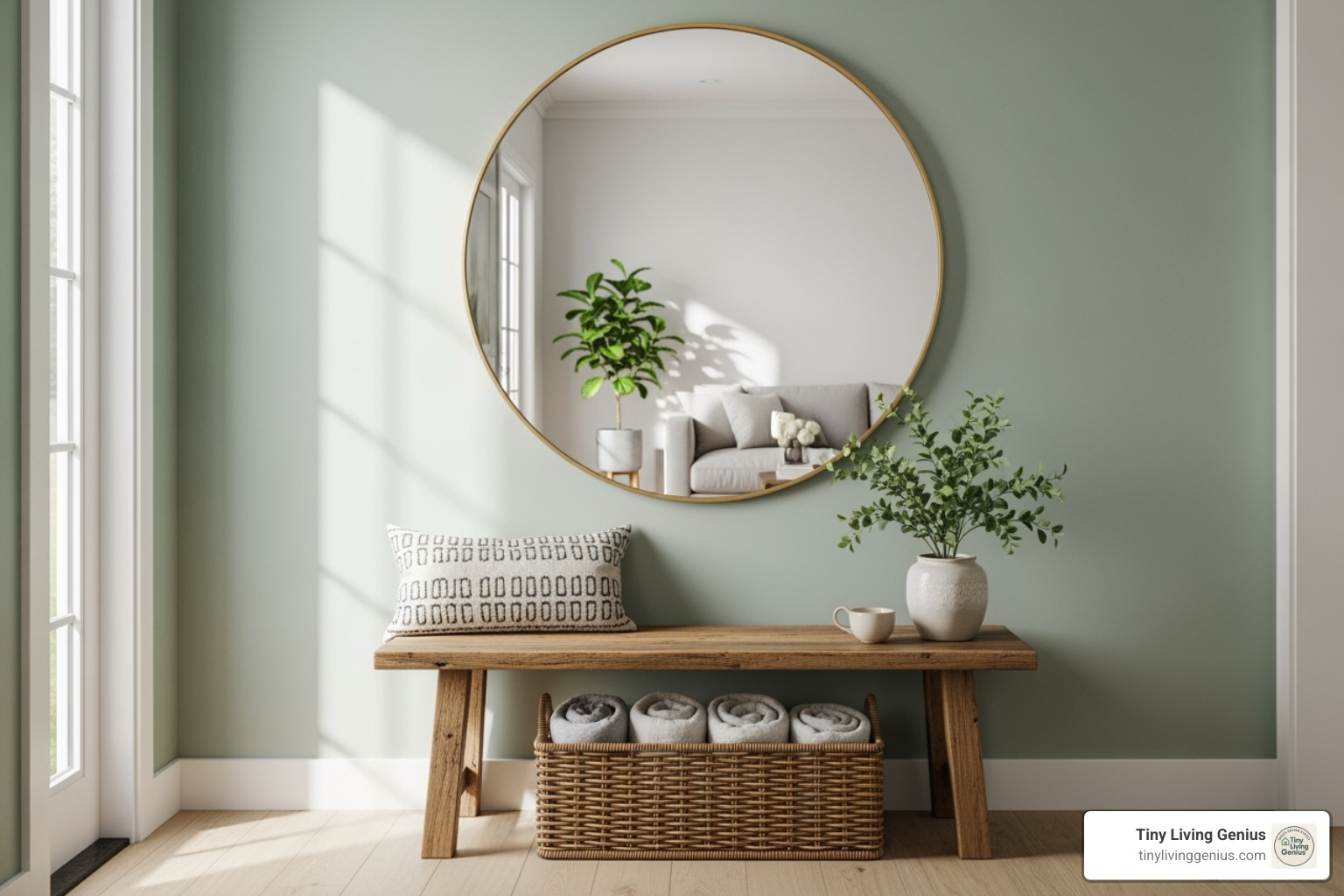
Use a large, eye-catching mirror as a focal point. Framed mirrored panels or a huge wall mirror can make an area feel doubled in size. A full-length mirror not only works for checking your outfit but also dramatically expands the space. Even a simple mirror above a small bench is perfect for a quick check before heading out. The secret is to place your mirror strategically to reflect natural light or a pleasant view.
Illuminating Your Space
Small entryways can often feel dark, so smart lighting is important for both function and aesthetics.
A striking light fixture can make a huge difference. A single, well-chosen piece can create a chic look, and a larger fixture can even make the room feel taller by drawing the eye upwards.
For smaller surfaces, a table lamp adds a warm, soft glow. Wall sconces are fantastic for providing ambient light without taking up precious surface space. For a touch of fun, string lights or hidden LED strip lighting can transform a simple entryway with a lovely ambiance.
Using Color and Pattern to Make an Impact
Color and pattern are secret weapons in your design toolbox for small entryway ideas. They can make a space feel larger, brighter, or simply give it a “wow” factor.
Light paint colors are a classic choice for making small spaces feel bigger, especially with natural light. Soft, pale colors can also open up a space. For example, cheerful yellow paint paired with crisp white trim can brighten a narrow entryway.
For a bolder look, an entryway is the perfect spot to experiment with a bold accent wall or statement wallpaper. Tasteful patterned wallpaper or a gorgeous mural can transform a plain entry. Whimsical wallpaper and a graphic rug can add a burst of energy.
Don’t forget the floor! Painted floors or patterned tiles can make a huge statement and add character underfoot, leaving a striking first impression without cluttering your walls.
Finally, consider the “fifth wall” – the ceiling. Painting the ceiling a lighter color can make the space feel taller. For a dramatic effect, a painted ceiling can add personality, and using complementary colors on walls and ceilings can visually connect different hallways. This smart use of color is a fantastic way to maximize vertical space in small spaces.
Creative & Budget-Friendly Small Entryway Ideas
Even the tiniest entryways deserve a touch of magic. Creative decor and smart budget choices can transform any small space into a welcoming and stylish introduction to your home. These small entryway ideas are about thoughtful touches and letting your personality shine the moment you step through the door.
Personalizing Your Space with Wall Decor
Think of your entryway walls as blank canvases waiting to reflect your home’s unique style.
A gallery wall is a fantastic way to maximize vertical space and infuse personality. When furniture options are limited, your walls are your best friend for making a statement.
Sometimes, less is more. A minimalist entry featuring a single, large-scale piece of art can make a huge impact, anchoring the space without making it feel cluttered.
For a functional touch, consider adding chalkboards or whiteboards, perfect for jotting down reminders or leaving greetings. Decorative hooks, like charming flower-shaped wall hooks, can offer a touch of whimsy while being useful.
To go beyond paint, adding textured wall panels can create depth and interest. A farmhouse feel can be achieved with textured walls and a simple wooden bench, while board and batten paneling with dark paint can give a moody entryway visual texture.
Budget-Friendly and DIY Small Entryway Ideas
Creating a beautiful entryway doesn’t have to break the bank. Many of our favorite small entryway ideas are surprisingly budget-friendly and can be fun DIY projects.
We love thrifted and repurposed furniture. A cute entryway can be assembled with a small wooden bench, a simple mirror, and a wicker basket—all affordable finds. You can also give new life to furniture from other rooms, like turning a petite dresser into a charming entryway table. Unique, midcentury-inspired pieces can often be found affordably by thrifting.
Get creative with DIY peg rails and storage. A wood slat wall can be a fantastic DIY project, offering both storage and visual appeal. You can easily craft your own peg rails for a custom look.
Don’t forget the magic of paint and stencils. Paint is a powerful and inexpensive tool. If you can’t fit much furniture, design the walls to make an impression with a stencil and some paint. Painting an interior door a bold, unexpected color can also add instant interest.
Incorporating Greenery and Natural Elements
Bringing a touch of nature into your small entryway can instantly make it feel fresher and more welcoming.
Potted plants are a simple yet effective way to add life. If floor space is tight, wall-mounted plants are a perfect solution. Placing a potted plant beside a console table can bring in a pop of color.
For easy updates, try seasonal branches or flowers displayed in a vase. Even a vase of preserved grasses adds a lovely natural touch that lasts.
Finally, incorporate natural textures like wicker baskets, wood accents, or a cowhide throw on a bench. These textures add warmth and visual interest without taking up precious space.
Frequently Asked Questions about Small Entryways
It’s normal to have questions about making the most of compact entry spaces. Let’s explore some of the most common ones with our expert advice.
How do you create an entryway when you don’t have one?
Many homes have a front door that opens directly into a living space, but you can still carve out a functional “non-entryway entryway.” It’s all about clever definition and smart choices.
First, define the space with a rug. A patterned area rug can clearly mark the transition point from outside to in, even in an open-plan layout. It instantly signals “this is the entryway.”
Next, create an essential “drop zone.” Use a slim console table or a floating shelf against the nearest wall. This provides a landing spot for keys and mail without blocking traffic flow.
Don’t forget to look up! Mount shelves and hooks to leverage vertical space. Install wall hooks for coats and bags to create a functional “wall entryway” without needing a dedicated nook.
Finally, if you have an unused corner near the door, consider a corner unit. A small corner shelf can provide storage without eating up linear wall space. The key is to create a distinct, functional zone, no matter how small.
What is the difference between an entryway and a foyer?
This is a great question. The distinction between an entryway and a foyer is mainly about size and formality.
An entryway is a general term for the immediate area inside a home’s main entrance. It could be a tiny landing, a narrow hall, or a designated spot in an open-concept room. Entryways prioritize practical, daily function.
A foyer, on the other hand, is generally a larger, more formal space. It’s often a separate room or a grander hall that acts as a transition area between the front door and the main living spaces. While all foyers are entryways, not all entryways are foyers.
How can I make my small entryway more welcoming?
Even the smallest entryways can exude warmth and make a fantastic first impression. A welcoming entryway sets the tone for your entire home.
First, add personal touches. This is your chance to infuse a bit of you into the space. Think family photos, a unique piece of art, or a small collection that reflects your interests.
Next, focus on warm lighting. Good lighting is key. Beyond overhead lights, consider a small table lamp for a soft, inviting glow or even string lights for a touch of cozy ambiance.
Incorporate greenery to instantly add life. A potted plant or a vase of fresh flowers can make a world of difference. Even seasonal branches add a lovely, natural touch.
A cozy rug is also a game-changer. It adds warmth, texture, and a pop of color while helping to define the space.
Finally, and most importantly, keep it clean and clutter-free. Nothing feels less welcoming than tripping over shoes. Use the smart small entryway ideas we’ve discussed to keep surfaces clear and floors tidy. A well-organized space ensures every entry and exit is as pleasant as possible.
Conclusion
Your entryway—no matter how small—is the handshake your home offers to the world. Creating a beautiful, functional entry isn’t about wishing for more square footage; it’s about making smart, intentional choices with what you have.
Throughout this guide, we’ve explored how small entryway ideas can transform challenging spaces. We’ve seen how slim console tables, storage benches, and floating shelves provide maximum function. We’ve learned that mirrors visually expand your area, while thoughtful lighting and color make the space feel intentional and impactful.
When you add personal touches like a potted plant or family photos, you create a space that doesn’t just function well but truly feels like home. The beauty of these strategies is that they work together to create a complete system that handles your daily needs while looking great. By avoiding common pitfalls like overcrowding, you ensure your entryway improves your daily routine.
At Tiny Living Genius, we’re passionate about helping you make every inch of your home work harder. When you implement these small entryway ideas, you’re creating a smoother morning routine, a warmer welcome for guests, and a home that reflects who you are.
Ready to tackle the rest of your small space? Explore more tiny apartment tips and find out how to make your entire home work beautifully, no matter its size.

